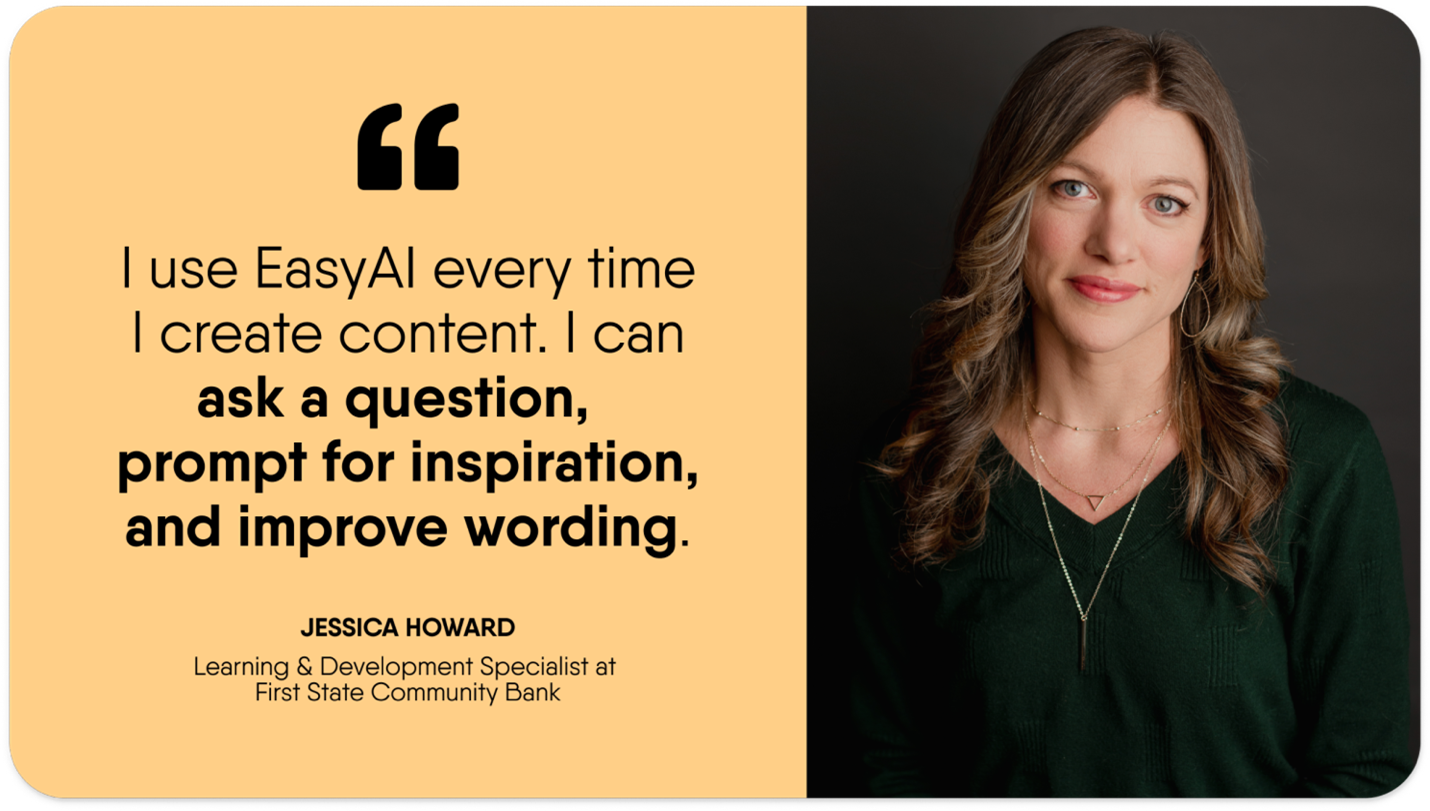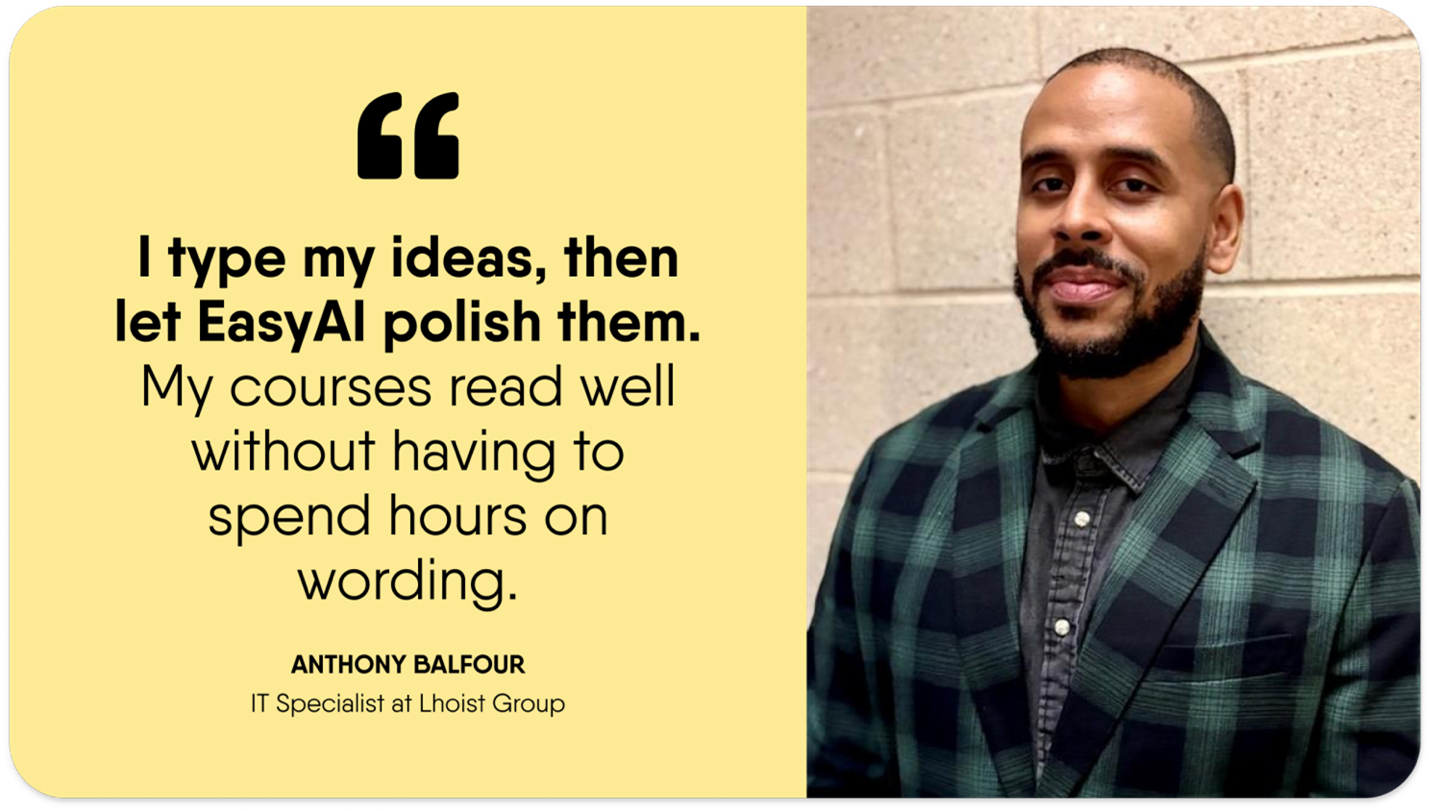What L&D teams have taught us about AI, 1,500 conversations later
)
When AI made its way into corporate learning, expectations were high. It promised to speed up course creation, remove bottlenecks, and scale training in a way that finally matched business needs.
That promise is starting to play out. But not always in the way we thought.
After reviewing more than 1,500 conversations with L&D professionals, one thing is clear: real-life use of AI is full of surprises. Some teams followed the "ideal flow". Others carved their own path using AI to rewrite dense compliance content, transform outdated slide decks, or clean up the language with a few bullet points.
The most consistent finding is that there is no one-size-fits-all approach. But when it clicks, the impact is hard to ignore.
The “ideal flow”: how AI was supposed to work
When we launched our EasyAI suite, the goal was to help anyone, not just instructional designers, create company-tailored training at scale. That meant speeding up every step of the process: converting old files to e-learning, structuring content, generating quizzes, translating into multiple languages, and more.
The plan was simple. Upload a document, let AI structure it, fine-tune it with a few Quick Actions, and then hit publish.
And in many cases, that worked. Teams created more than 75,000 AI-powered courses since April 2023. Content creation got up to 9x faster. The number of active course authors went up by 75%. These results came from teams who used AI as a co-author, never expecting it to be perfect but letting it do the heavy lifting so they could move faster.
But that’s just one side of the story.

The real flow: creative uses and unexpected wins
Many teams didn’t follow the ideal flow. Instead, they experimented and found new ways AI could add value.
A manufacturing company lets engineers write raw notes and then uses Quick Actions to rewrite them into clear, instructional content. One team uploaded old training files to refresh the tone and modernise the wording. Another used AI to simplify legal jargon and generate quiz questions for a GDPR course.
Some used PowerPoint files not to create a course directly, but to feed background knowledge into the system, treating AI like a collaborator, not a tool with fixed rules.
These teams weren’t just working faster. They were working smarter, repurposing what they already had and turning static content into real training. AI can do more than build a course. It can bring clarity, structure, and engagement to materials that usually get skipped or skimmed.
The blockers: why some teams still hold back
For every success story, there were also signs that adoption takes time. In fact, most L&D professionals we spoke to weren’t rejecting AI; they were cautiously testing it.
Some were unsure where to start, and others were waiting for legal approval. Internal policies often paused or slowed AI use in heavily regulated industries like healthcare and finance.
Some were unsure of the quality. Would the content be accurate? What if something AI-generated was factually wrong or sounded off-brand?
In these cases, trust mattered. Teams with internal review processes, or AI “champions” who guided others, found it easier to build confidence. Even small use cases helped, like using AI to improve tone or summarise dense paragraphs. Those first wins often led to broader adoption.
As we explored in our latest "Learning Loop" newsletter edition", the most significant shift happens when teams stop asking, “Can AI do this?” and start asking, “Where does AI help us most?”
AI works best when humans stay in the loop
Our conversations made one thing clear: the most effective use of AI happens when L&D teams treat AI as a starting point, not a finished product.
Teams that succeed know AI can write a first draft, but it’s their expertise that turns it into something valuable. AI gets you 70% there. The last 30% is the review, the voice, and the context; that’s where people come in.
This isn’t a limitation. It’s a strength. When AI handles the structure and formatting, L&D teams get to focus on what really matters: relevance, clarity, and impact.
This dynamic plays out especially well in teams using Employee-generated Learning. AI makes it easier for employees to share what they know, even if they’ve never created training before. With course outlines, writing prompts, and tone correction, the gap between subject-matter expertise and the finished course gets much smaller.
AI lets L&D lead at scale
In many companies, AI is already transforming how learning scales. Traditionally, L&D teams were overwhelmed by training requests, especially when the same team had to structure content, format it, review it, and translate it.
Now, we’re seeing that change. When employees create their own training with AI support, L&D teams can redirect their time and focus to what matters most: setting content standards, guiding strategic initiatives, or improving learning outcomes across the business.
Brandon Hall Group’s 2025 report backs this up. According to the research:
- 87% of organisations say automated content creation is critical for the future of L&D.
- 41% already report efficiency gains from AI automation.
- By the end of 2025, 89% expect AI to have a high or moderate impact on L&D operations.
But perhaps the most telling stat? Only 28% say they’ve achieved personalised learning at scale. That’s where AI still has the most untapped potential.
AI makes personalisation more realistic
Most learners don’t want more training. They want better training that is relevant, timely, and in their language.
AI is finally making that possible. One of our customers, Keune Haircosmetics, used EasyAI's auto-translation feature to localise training into 21 languages in just one year. Before that, they offered just five.
The tools behind this aren’t magic. They’re simply practical. With AI-powered auto-translation, content goes global without waiting on vendors or overloading internal teams. With glossary support, the tone stays on brand. And with doc-to-course tools, the starting point can be a PowerPoint, a manual, or a policy document.
Personalisation doesn’t mean building a custom course for every role. It means helping employees get training that fits their job, language, and level of knowledge without starting from scratch each time.
Where AI fits best (for now)
We saw a pattern across all our conversations. The most successful use cases weren’t the most advanced; they were the most practical.
Here’s where AI made the most significant difference:
- Improving clarity: simplifying long paragraphs or rewriting technical text.
- Generating knowledge checks: creating quiz questions in seconds.
- Structuring messy content: turning raw notes into structured lessons.
- Speeding up localisation: translating without back-and-forth emails.
- Refreshing old materials: updating tone, language, or formatting.
These kinds of tasks take time but not deep creative thinking. When AI takes them over, people can spend their energy on high-impact work.
That’s why so many teams start small. They don’t try to “AI everything.” They test one use case, see the value, and build from there.

A new role for L&D
AI isn’t just changing how we build training. It’s changing what L&D teams do.
When AI handles formatting, structuring, and translation, L&D gets time back. That opens the door for something more strategic: guiding what people create, helping teams understand best practices, and ensuring training meets real business needs.
As AI continues to evolve, the role of L&D is shifting from creator to curator, from gatekeeper to guide.
That might be a significant change. But as many teams are already discovering, it’s also a big opportunity.
Kasper Spiro 
Co-founder and Chief Learning Strategist, Easygenerator


)
)
)
)
)
)
)
)
)
)
)
)
)
)
)
)
)
)
)
)
)
)
)
)
)
)
)
)
)
)
)
)